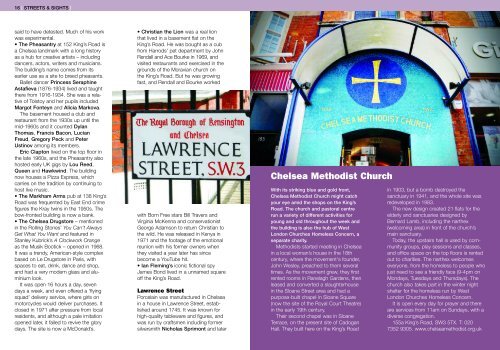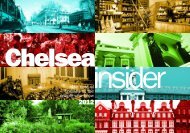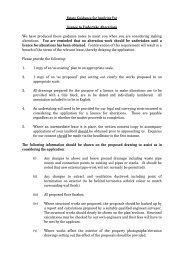The best of Chelsea by the people who know - Cadogan
The best of Chelsea by the people who know - Cadogan
The best of Chelsea by the people who know - Cadogan
Create successful ePaper yourself
Turn your PDF publications into a flip-book with our unique Google optimized e-Paper software.
16 | STREETS & SIGHTS |<br />
said to have detested. Much <strong>of</strong> his work<br />
was experimental.<br />
• <strong>The</strong> Pheasantry at 152 King’s Road is<br />
a <strong>Chelsea</strong> landmark with a long history<br />
as a hub for creative artists – including<br />
dancers, actors, writers and musicians.<br />
<strong>The</strong> building’s name comes from its<br />
earlier use as a site to breed pheasants.<br />
Ballet dancer Princess Seraphine<br />
Astafieva (1876-1934) lived and taught<br />
<strong>the</strong>re from 1916-1934. She was a relative<br />
<strong>of</strong> Tolstoy and her pupils included<br />
Margot Fonteyn and Alicia Markova.<br />
<strong>The</strong> basement housed a club and<br />
restaurant from <strong>the</strong> 1930s up until <strong>the</strong><br />
mid-1960s and it counted Dylan<br />
Thomas, Francis Bacon, Lucian<br />
Freud, Gregory Peck and Peter<br />
Ustinov among its members.<br />
Eric Clapton lived on <strong>the</strong> top floor in<br />
<strong>the</strong> late 1960s, and <strong>the</strong> Pheasantry also<br />
hosted early UK gigs <strong>by</strong> Lou Reed,<br />
Queen and Hawkwind. <strong>The</strong> building<br />
now houses a Pizza Express, which<br />
carries on <strong>the</strong> tradition <strong>by</strong> continuing to<br />
host live music.<br />
• <strong>The</strong> Markham Arms pub at 138 King’s<br />
Road was frequented <strong>by</strong> East End crime<br />
figures <strong>the</strong> Kray twins in <strong>the</strong> 1950s. <strong>The</strong><br />
bow-fronted building is now a bank.<br />
• <strong>The</strong> <strong>Chelsea</strong> Drugstore – mentioned<br />
in <strong>the</strong> Rolling Stones’ You Can’t Always<br />
Get What You Want and featured in<br />
Stanley Kubrick’s A Clockwork Orange<br />
as <strong>the</strong> Musik Bootick – opened in 1968.<br />
It was a trendy, American-style complex<br />
based on Le Drugstore in Paris, with<br />
spaces to eat, drink, dance and shop,<br />
and had a very modern glass and aluminium<br />
look.<br />
It was open 16 hours a day, seven<br />
days a week, and even <strong>of</strong>fered a ‘flying<br />
squad’ delivery service, where girls on<br />
motorcycles would deliver purchases. It<br />
closed in 1971 after pressure from local<br />
residents, and although a pale imitation<br />
opened later, it failed to revive <strong>the</strong> glory<br />
days. <strong>The</strong> site is now a McDonald’s.<br />
• Christian <strong>the</strong> Lion was a real lion<br />
that lived in a basement flat on <strong>the</strong><br />
King’s Road. He was bought as a cub<br />
from Harrods’ pet department <strong>by</strong> John<br />
Rendall and Ace Bourke in 1969, and<br />
visited restaurants and exercised in <strong>the</strong><br />
grounds <strong>of</strong> <strong>the</strong> Moravian church on<br />
<strong>the</strong> King’s Road. But he was growing<br />
fast, and Rendall and Bourke worked<br />
with Born Free stars Bill Travers and<br />
Virginia McKenna and conservationist<br />
George Adamson to return Christian to<br />
<strong>the</strong> wild. He was released in Kenya in<br />
1971 and <strong>the</strong> footage <strong>of</strong> <strong>the</strong> emotional<br />
reunion with his former owners when<br />
<strong>the</strong>y visited a year later has since<br />
become a YouTube hit.<br />
• Ian Fleming’s iconic fictional spy<br />
James Bond lived in a unnamed square<br />
<strong>of</strong>f <strong>the</strong> King’s Road.<br />
Lawrence Street<br />
Porcelain was manufactured in <strong>Chelsea</strong><br />
in a house in Lawrence Street, established<br />
around 1745. It was <strong>know</strong>n for<br />
high-quality tableware and figures, and<br />
was run <strong>by</strong> craftsmen including former<br />
silversmith Nicholas Sprimont and later<br />
<strong>Chelsea</strong> Methodist Church<br />
With its striking blue and gold front,<br />
<strong>Chelsea</strong> Methodist Church might catch<br />
your eye amid <strong>the</strong> shops on <strong>the</strong> King’s<br />
Road. <strong>The</strong> church and pastoral centre<br />
run a variety <strong>of</strong> different activities for<br />
young and old throughout <strong>the</strong> week and<br />
<strong>the</strong> building is also <strong>the</strong> hub <strong>of</strong> West<br />
London Churches Homeless Concern, a<br />
separate charity.<br />
Methodists started meeting in <strong>Chelsea</strong><br />
in a local woman’s house in <strong>the</strong> 18th<br />
century, where <strong>the</strong> movement's founder,<br />
John Wesley, preached to <strong>the</strong>m several<br />
times. As <strong>the</strong> movement grew, <strong>the</strong>y first<br />
rented rooms in Ranelagh Gardens, <strong>the</strong>n<br />
leased and converted a slaughterhouse<br />
in <strong>the</strong> Sloane Street area and had a<br />
purpose-built chapel in Sloane Square<br />
(now <strong>the</strong> site <strong>of</strong> <strong>the</strong> Royal Court <strong>The</strong>atre)<br />
in <strong>the</strong> early 19th century.<br />
<strong>The</strong>ir second chapel was in Sloane<br />
Terrace, on <strong>the</strong> present site <strong>of</strong> <strong>Cadogan</strong><br />
Hall. <strong>The</strong>y built here on <strong>the</strong> King’s Road<br />
in 1903, but a bomb destroyed <strong>the</strong><br />
sanctuary in 1941, and <strong>the</strong> <strong>who</strong>le site was<br />
redeveloped in 1983.<br />
<strong>The</strong> new design created 21 flats for <strong>the</strong><br />
elderly and sanctuaries designed <strong>by</strong><br />
Bernard Lamb, including <strong>the</strong> nar<strong>the</strong>x<br />
(welcoming area) in front <strong>of</strong> <strong>the</strong> church’s<br />
main sanctuary.<br />
Today, <strong>the</strong> upstairs hall is used <strong>by</strong> community<br />
groups, play sessions and classes,<br />
and <strong>of</strong>fice space on <strong>the</strong> top floors is rented<br />
out to charities. <strong>The</strong> nar<strong>the</strong>x welcomes<br />
everyone, from <strong>the</strong> homeless to <strong>people</strong> <strong>who</strong><br />
just need to see a friendly face (9-4pm on<br />
Mondays, Tuesdays and Thursdays). <strong>The</strong><br />
church also takes part in <strong>the</strong> winter night<br />
shelter for <strong>the</strong> homeless run <strong>by</strong> West<br />
London Churches Homeless Concern.<br />
It is open every day for prayer and <strong>the</strong>re<br />
are services from 11am on Sundays, with a<br />
diverse congregation.<br />
155a King’s Road, SW3 5TX. T: 020<br />
7352 9305. www.chelseamethodist.org.uk







